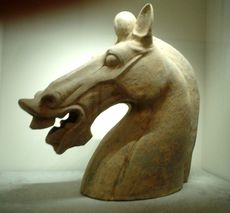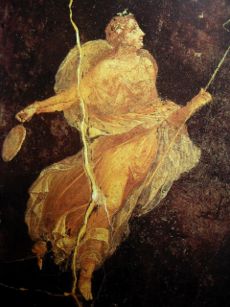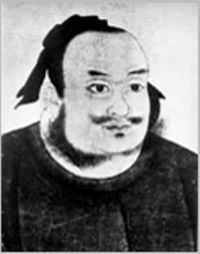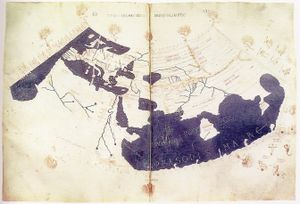Sino-Roman relations
2007 Schools Wikipedia Selection. Related subjects: Ancient History, Classical History and Mythology
Sino-Roman relations started first on an indirect basis during the 2nd century BC. China and Rome progressively inched closer with the embassies of Zhang Qian in 130 BC and the military expeditions of China to Central Asia, until general Ban Chao attempted to send an envoy to Rome around 100 AD. Several alleged Roman embassies to China were recorded by a number of ancient Chinese historians. The first one on record, supposedly from either the Roman emperor Antoninus Pius or the later emperor Marcus Aurelius, arrived in 166 AD.
Preceding history
The rapid growth of Roman commerce with ancient China likely would not have been possible without two major preceding developments, first by Alexander the Great and the ancient Greeks, and second by the spread of embassies of the Han Dynasty into Central and Western Asia.
Development of trade links
The first major step in opening trade links between the East and the West came with the expansion of Alexander the Great deep into Central Asia, as far as the Fergana Valley at the borders of the modern-day Xinjiang region of China, where he founded in 329 BC a Greek settlement in the city of Alexandria Eschate "Alexandria The Furthest", Khujand (also called Khozdent or Khojent — formerly Leninabad), in the modern state of Tajikistan. The Greeks were to remain in Central Asia for the next three centuries, first through the administration of the Seleucid Empire, and then with the establishment of the Greco-Bactrian Kingdom in Bactria. They kept expanding eastward, especially during the reign of Euthydemus I (230-200 BC), who extended his control to Sogdiana, reaching and going beyond the city of Alexandria Eschate. There are indications that he may have led expeditions as far as Kashgar in Xinjiang, possibly leading to the first known contacts between China and the West around 200 BC. The Greek historian Strabo writes that "they extended their empire even as far as the Seres (China) and the Phryni" ( Strabo XI.XI.I). The Han Dynasty appears called the people of the Fergana the Ta-Yuan.
Zhang Qian's embassy
The next step came around 130 BC, with the embassies of the Han Dynasty to Central Asia, following the reports of the ambassador Zhang Qian (who was originally sent to obtain an alliance with the Yuezhi against the Xiongnu, but in vain). The Chinese emperor Wudi became interested in developing relationships with the sophisticated urban civilizations of Ferghana, Bactria and Parthia: “The Son of Heaven on hearing all this reasoned thus: Ferghana (Dayuan) and the possessions of Bactria (Daxia) and Parthia (Anxi) are large countries, full of rare things, with a population living in fixed homes and given to occupations somewhat identical with those of the Chinese people, but with weak armies, and placing great value on the rich produce of China” Hou Hanshu ( Later Han History).
The Chinese subsequently sent numerous embassies, around ten every year, to these countries and as far as Seleucid Syria. “Thus more embassies were dispatched to Anxi ( Parthia), Yancai (who later joined the Alans), Lijian (Syria under the Seleucids), Tiaozhi ( Chaldea) and Tianzhu (northwestern India)… As a rule, rather more than ten such missions went forward in the course of a year, and at the least five or six.” Hou Hanshu (Later Han History).
Chinese silk in the Roman Empire
Trade with the Roman Empire followed soon, confirmed by the Roman craze for Chinese silk (supplied through the Parthians) from the 1st century BC. The Romans were not aware of silkworms and thought the fibre a vegetable product:
- The Seres (Chinese), are famous for the woolen substance obtained from their forests; after a soaking in water they comb off the white down of the leaves… So manifold is the labour employed, and so distant is the region of the globe drawn upon, to enable the Roman maiden to flaunt transparent clothing in public — ( Pliny the Elder, The Natural History VI, 54 ).
The Senate issued, in vain, several edicts to prohibit the wearing of silk, on economic and moral grounds: the importation of Chinese silk caused a huge outflow of gold, and silk clothes were considered to be decadent and immoral:
- I can see clothes of silk, if materials that do not hide the body, nor even one's decency, can be called clothes... Wretched flocks of maids labour so that the adulteress may be visible through her thin dress, so that her husband has no more acquaintance than any outsider or foreigner with his wife's body—( Seneca the Younger (c. 3 BC– 65 AD, Declamations Vol. I).
The Roman historian Florus also describes the visit of numerous envoys, including Seres (perhaps the Chinese), to the first Roman Emperor Augustus, who reigned between 27 BC and 14 AD:
- Now that all the races of the west and south were subjugated, and also the races of the north, (...) the Scythians and the Sarmatians sent ambassadors seeking friendship; the Seres too and the Indians, who live immediately beneath the sun, though they brought elephants amongst their gifts as well as precious stones and pearls, regarded their long journey, in the accomplishment of which they had spent four years, as the greatest tribute which they rendered, and indeed their complexion proved that they came from beneath another sky.—( Florus Epitomae II, 34).
A maritime route opened up between Chinese-controlled Jiaozhi (centred in modern Vietnam, near Hanoi) probably by the 1st century AD. It extended, via ports on the coasts of India and Sri Lanka, all the way to Roman-controlled ports in Egypt and the Nabataean territories on the northeastern coast of the Red Sea. The Hou Hanshu records that a delegation of Roman envoys arrived in China by this maritime route in 166 AD; this may well have been an exaggeration, by the envoys or the scribe, of a party of Roman merchants.
Castaways
Pomponius Mela ( Book III,Chapter 5), copied by Pliny the Elder, wrote that Quintus Caecilius Metellus Celer, proconsul in Gaul, 59 BC, got 'several Indians' (Indi) as a present from a Germanic king. The Indians were driven by a storm to the coasts of Germania (in tempestatem ex Indicis aequoribus):
- Metellus Celer recalls the following: when he was Proconsul in Gaul, he was given people from India by the king of the Sueves; upon asking why they were in this land, he learnt that they were caught in a storm away from India, that they became castaways, and finally landed on the coasts of Germany. They thus resisted the sea, but suffered from the cold for the rest of their travel, and that is the reason why they left. (Sueves is an emendation to the text.)
It is unclear whether these castaways were people from India or Eastern Asia, since "Indians" designated all Asians, Indian and beyond, during Roman times. Pomponius is using these Indi as evidence for the Northeast Passage and the northward strait out of the Caspian Sea (which in Antiquity was usually thought to be open to Oceanus in the north). Edward Herbert Bunbury suggests that they were of Finnish origin. There are also some speculations that they may have been American Indians castaway across the Atlantic.
Some confusion may be suspected in this passage since Metellus Celer died before taking up his proconsulship, thus leaving it free for Julius Caesar.
Roman soldiers in the East
There are several known instances of Roman soldiers being captured by the Parthians and transferred to the East for border duty. According to Pliny, in 54 BC, after losing at the battle of Carrhae, 10,000 Roman prisoners were displaced by the Parthians to Margiana to man the frontier (Plin. Hist. Nat. 6. 18 ).
The Chinese have an account by Ban Gu of soldiers under the command of the nomadic chief Jzh Jzh who fought in a so-called "fish-scale formation". The historian Homer Dubs claimed that this might have been the Roman testudo formation and that these men, who were captured by the Chinese, were able to found the city Liqian (Li-chien). However there is precisely no evidence that these men were Romans or that this claim is anything other than speculation. .
A Roman inscription of the 2nd—3rd centuries AD has been found in eastern Uzbekistan in the Kara-Kamar cave complex, which has been analysed as belonging to some Roman soldiers from the Pannonian Legio XV Apollinaris :
The expedition of Ban Chao
In 97, the Chinese general Ban Chao crossed the Tian Shan and Pamir Mountains with an army of 70,000 men in a campaign against the Xiongnu. He went as far west as the Caspian Sea, reaching the territory of Parthia, upon which event he reportedly also sent an envoy named Gan Ying to Daqin (Rome). Gan Ying left a detailed account of western countries, although he only reached as far as Mesopotamia. He intended to sail to Rome through the Black Sea, but some Parthian merchants, interested in maintaining their profitable role as the middleman in trade between Rome and China, told him the trip would take two years at least (when it was actually closer to two months). Deterred, he returned home.
Gan Ying left an account on Rome ( Daqin in Chinese) which may have relied on second-hand sources. He locates it to the west of the sea:
- Its territory covers several thousand li [a "li" is around half a kilometre], it has over 400 walled cities. Several tens of small states are subject to it. The outer walls of the cities are made of stones. They have established posting stations… There are pines and cypresses. (Hou Hanshu, cited in Leslie and Gardiner).
He also describes the adoptive monarchy of the Emperor Nerva, and Roman physical appearance and products:
- As for the king, he is not a permanent figure but is chosen as the man most worthy… The people in this country are tall and regularly featured. They resemble the Chinese, and that is why the country is called Da Qin (The "Great" Qin)… The soil produced lots of gold, silver and rare jewels, including the jewel which shines at night… they sew embroidered tissues with gold threads to form tapestries and damask of many colours, and make a gold-painted cloth, and a "cloth washed-in-the-fire" ( asbestos). (Hou Hanshu, cited in Leslie and Gardiner).
Finally Gan Ying determines Rome correctly as the main economic power at the western end of Eurasia:
- It is from this country that all the various marvellous and rare objects of foreign states come. (Hou Hanshu, cited in Leslie and Gardiner).
First Roman embassy
With the expansion of the Roman Empire in the Middle-East during the 2nd century, the Romans gained the capability to develop shipping and trade in the Indian Ocean. Several ports have been excavated on the coast of India which contain Roman remains.
Several Romans probably travelled farther to the East, either on Roman, Indian or Chinese ships. The first group of people claiming to be an embassy of Romans to China is recorded in 166, sixty years after the expeditions to the west of the Chinese general Ban Chao. It came to Emperor Huan of Han China, "from Antun (Emperor Antoninus Pius), king of Daqin (Rome)". Although, as Antoninus Pius died in 161, while the convoy arrived in 166, if genuine, it may have been from Marcus Aurelius, who was emperor in 166. The confusion arises because Marcus Aurelius was formally adopted by his predecessor and took his names as additional names.
The mission came from the South, and therefore probably by sea, entering China by the frontier of Jinan or Tonkin. It brought presents of rhinoceros horns, ivory, and tortoise shell, which had probably been acquired in Southern Asia. About the same time, and possibly through this embassy, the Chinese acquired a treatise of astronomy from Daqin (Chinese name of the Roman Empire).
The existence of China was clearly known to Roman cartographers of the time, since its name and position is depicted in Ptolemy's Geographia, which is dated to c. 150. It is located beyond the Aurea Chersonesus ("Golden Peninsula"), which refers to the Southeast Asian peninsula. It is shown as being on the Magnus Sinus ("Great Gulf"), which presumably corresponds to the known areas of the China Sea at the time; although Ptolemy represents it as tending south-east rather than north-east. Trade throughout the Indian Ocean was extensive from the 2nd century, and many trading ports have been identified in India and Sri Lanka with Roman communities, through which the Roman embassy passed.
Other Roman embassies
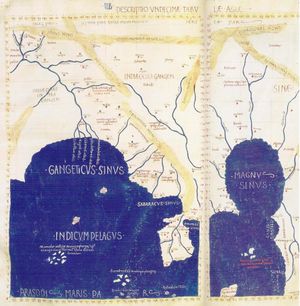
Other embassies may have been sent after this first encounter, but were not recorded, until an account appears about presents sent in the early 3rd century by the Roman Emperor to the Emperor Taitsu of the Kingdom of Wei (reigned 227– 239) in Northern China. The presents consisted of articles of glass in a variety of colours. While several Roman Emperors ruled during this time, the embassy, if genuine, may have been sent by Alexander Severus; since his successors reigned briefly and were busy with civil wars.
Another embassy from Daqin is recorded in the year 284, as bringing "tribute" to the Chinese empire. This embassy presumably was sent by the Emperor Carus ( 282– 283), whose short reign was occupied with war with Persia.
